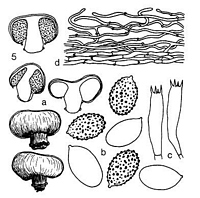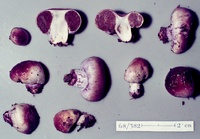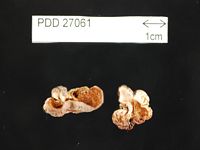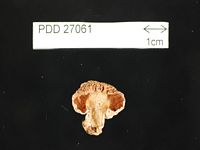|
 Cortinarius violaceovolvatus Cortinarius violaceovolvatus
SynonymsThaxterogaster violaceovolvatus
BiostatusPresent in region - Indigenous. Endemic
Images (click to enlarge)
Caption: Thaxterogaster
violaceovolvatum Hk. sp.n. (type): a. fruitingbodies.
b. spores. c. basidia. d. cuticle. | 
Caption: ZT68-382, Holotype
Owner: E. Horak: © Creative Commons Attribution-Noncommercial 3.0 New Zealand | 
Caption: Dried type specimen
Owner: Herb PDD | 
Caption: Dried type specimen
Owner: Herb PDD | |
Article: Horak, E. (1973). Fungi Agaricini Novazelandiae I-V. Beihefte zur Nova Hedwigia 43: 200 p.
Description: Gastrocarp
15-30 x 8-20 mm, globose or ovoid when young, becoming depressed at the centre,
margin of the peridium appressed to the stipe but in the end partially exposing
the gleba, at the centre red-brown or chestnut brown, towards the margin lilac
or violaceous (like Phlegmacium dibaphum), colours fading on over-mature
carpophores, glutinous, smooth, margin without veil remnants. Gleba loculate,
chambers irregularly arranged, up to 2 mm diam., rust brown, exposed in aged
specimens but always covered with white or lilac fibrils. Stipe 10-20 x 7-10
µm, cylindric, attenuated towards the apex (columella), and extending above
into the cuticular layer of the peridium, white or lilac, longitudinally covered
with white or lilac fibrils, glutinous and membranaceous ring or volva present,
initially ring or volva continuous with the gelatinous cuticle of the peridium.
Context white, not gelatinised. Odor unpleasant, like acetylene. Taste mild.
Chemical reactions on peridium: KOH and HCl- negative.
Spores
11-14 x 7-8.5 µm, ovoid or elliptic-oblong, mostly axially symmetric, verrucose,
warts coarser towards the apex, ferruginous, germ pore absent. Basidia 30-40
x 8 µm, 4-spored. Cystidia absent. Epicutis consisting of a thick layer of strongly
gelatinised, hyaline hyphae (2-6 µm diam.), with a thin-walled membrane, clamp
connections numerous.
Habitat: On
ground under Nothofagus cliffortioides, N. menziesii and N. fusca.
New Zealand.
Notes: Th. violaceovolvatum Hk. is suggestive
of three other species of Thaxterogaster (Th. glutinopallens Hk., Th.
lubricum Moser, Th. gliocyclum Hk.) occurring in the Nothofagus
forests of South America. The distinct red-brown and lilac colours, however,
serve to separate clearly the New Zealand species from their relatives in Patagonia.
With respect to the microscopical characters all four species also show close
relationships.
|